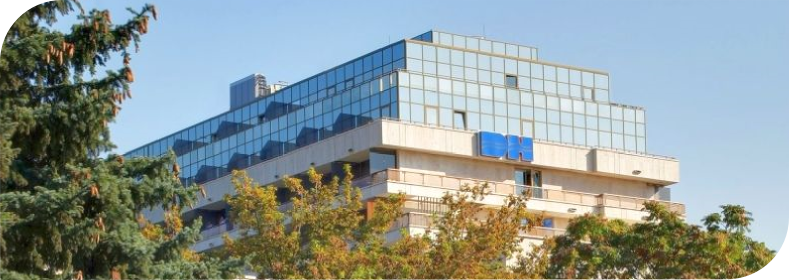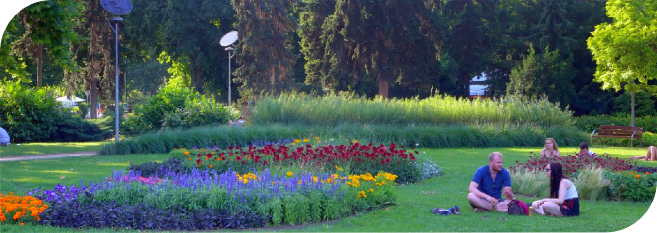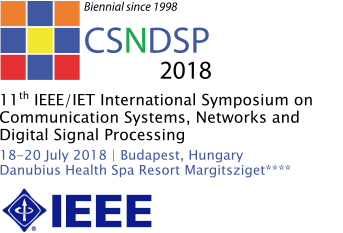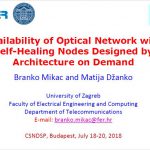Availability Improvement of Optical Networks with Self-Healing Nodes Designed by Architecture on Demand
/Authors: Branko Mikac and Matija Dzanko/
ABSTRACT
Definition of basic measures for system availability, reliability and security. Definitions of network availability. Time and space complexity of availability evaluation algorithms. Appropriate measure choice for optical telecommunication system and network. Protection and restoration scenarios in optical networks. Availability sensitivity.
Application of architecture on demand (AoD) in optical nodes aiming to achieve self-healing capability. Comparison of AoD to hard-wired (HW) nodes. Tradeoff between AoD advantages and disadvantages based on availability figures. Integrated availability optimization in both node and network levels. Routing changes in nodes with the purpose to increase fibre switching and, consequently, increase availability of node and network. Algorithm DPP EFS for Enforced Fiber Switching in the case of Dedicated Path Protection (1+1) is presented. Monte Carlo simulations of node failures were carried out on German and European topologies. Trade off analysis by comparing mean down time and st-availability vs. different traffic loads (number of light paths) and node architectures. In addition, the influence of investing in redundancy of AoD architectures are evaluated.
BIOGRAPHY
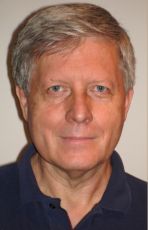 Branko Mikac received B.Sc., M.Sc., and Ph.D. degrees in electrical engineering from the University of Zagreb, Faculty of Electrical Engineering and Computing (FER), in 1970, 1980 and 1986, respectively. He is full professor since 2003. His teaching and research areas of interest are related to complex system reliability and availability of photonic transmission networks. From 1970 to 1974 he was with the Institute for Electronics, Telecommunications and Automation, RIZ, Zagreb. Since 1974 he has been working at University of Zagreb, Faculty of Electrical Engineering, Department of Telecommunication. In the period 2000-2004 he was head of the department. He participated in COST projects: 239, 266 and 291. He participated in FP6 Network of Excellence (NoE): e-Photon/ONe (2004 – 2008) and FP7 NoE BONE (2008 –2010). In the NoEs he was the leader of working packeges for education. He was leading organization of summer/winter schools in Mons, Aveiro, Cesanatico/Pisa, Zagreb, Brest, Krakow and Budapest. He participated in editing of 5 books, co-authored 7 chapters, and published more than 60 papers in journals and conference proceedings. He is a member of IEEE. He was awarded in 2007 by the FER with the Golden medal for introducing European projects in the faculty. He provides courses on BSc (Telecommunication systems and networks), MS (Photonic telecommunication networks and Reliability of telecommunication networks), and PhD level (Optical transmission networks and Network availability). He supervised more than 100 Master and 6 PhD students.
Branko Mikac received B.Sc., M.Sc., and Ph.D. degrees in electrical engineering from the University of Zagreb, Faculty of Electrical Engineering and Computing (FER), in 1970, 1980 and 1986, respectively. He is full professor since 2003. His teaching and research areas of interest are related to complex system reliability and availability of photonic transmission networks. From 1970 to 1974 he was with the Institute for Electronics, Telecommunications and Automation, RIZ, Zagreb. Since 1974 he has been working at University of Zagreb, Faculty of Electrical Engineering, Department of Telecommunication. In the period 2000-2004 he was head of the department. He participated in COST projects: 239, 266 and 291. He participated in FP6 Network of Excellence (NoE): e-Photon/ONe (2004 – 2008) and FP7 NoE BONE (2008 –2010). In the NoEs he was the leader of working packeges for education. He was leading organization of summer/winter schools in Mons, Aveiro, Cesanatico/Pisa, Zagreb, Brest, Krakow and Budapest. He participated in editing of 5 books, co-authored 7 chapters, and published more than 60 papers in journals and conference proceedings. He is a member of IEEE. He was awarded in 2007 by the FER with the Golden medal for introducing European projects in the faculty. He provides courses on BSc (Telecommunication systems and networks), MS (Photonic telecommunication networks and Reliability of telecommunication networks), and PhD level (Optical transmission networks and Network availability). He supervised more than 100 Master and 6 PhD students.
PRESENTATION
